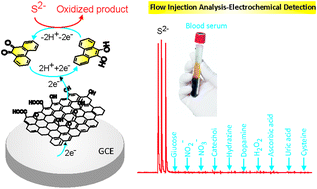A blood-serum sulfide selective electrochemical sensor based on a 9,10-phenanthrenequinone-tethered graphene oxide modified electrode
Abstract
The sulfide ion and its associated species (H2S and HS−) are widely referred to as toxic chemicals. However, at concentrations of ∼10–100 μM, it serves as a neurotransmitter and signaling agent in biological systems. Abnormalities in blood serum sulfide can be an indication of several diseases, including diabetes, wherein there is a significant reduction in the sulfide ion concentration (<10 μM). Herein, we wish report a 9,10-phenanthrenequinone (PQn) tethered graphene oxide (GO) modified glassy carbon electrode (GCE/GO@PQn) for the highly selective and stable electrocatalytic oxidation and flow injection analysis (FIA) of sulfide ions. The electrode exhibits a detection range of 1–100 μM, and is suitable for the common biochemical interference-free detection of blood serum sulfide in pH 7 phosphate buffer solution. The modified electrode was found to be tolerant of interfering chemicals such as cysteine, uric acid, ascorbic acid, nitrate, glucose, hydrogen peroxide, nitrate, nitrite and dissolved oxygen. This is unlike conventional redox mediator modified electrodes, which all show marked interference with the above-mentioned chemicals during sulfide detection. A constructed FIA calibration plot (applied potential, Eapp = 0.15 V vs. Ag/AgCl) was linear in the sulfide concentration ranges of 1–100 μM (1st region) and 300 μM–5 mM (2nd region) with a detection limit value of 700 nM. The selective and quick FIA of sulfide ions in three diabetic patient blood samples along with a control was demonstrated as a proof of concept.



 Please wait while we load your content...
Please wait while we load your content...